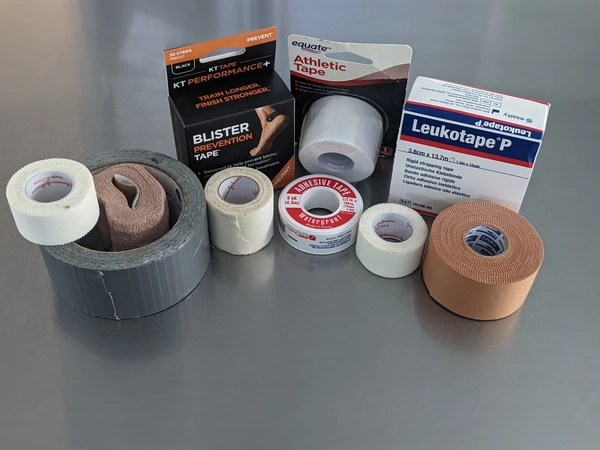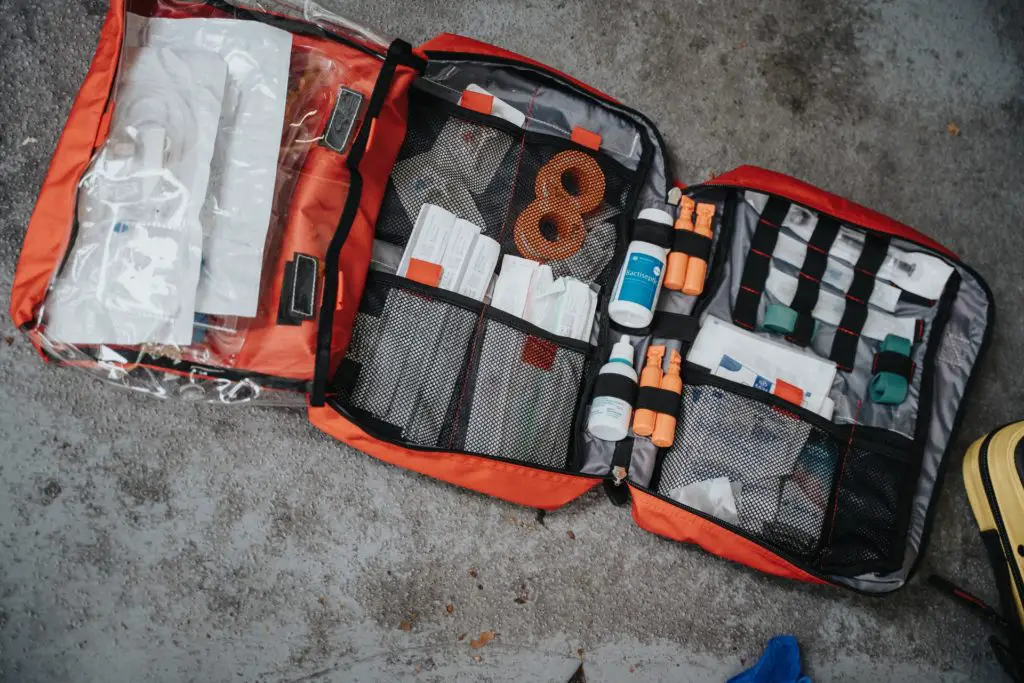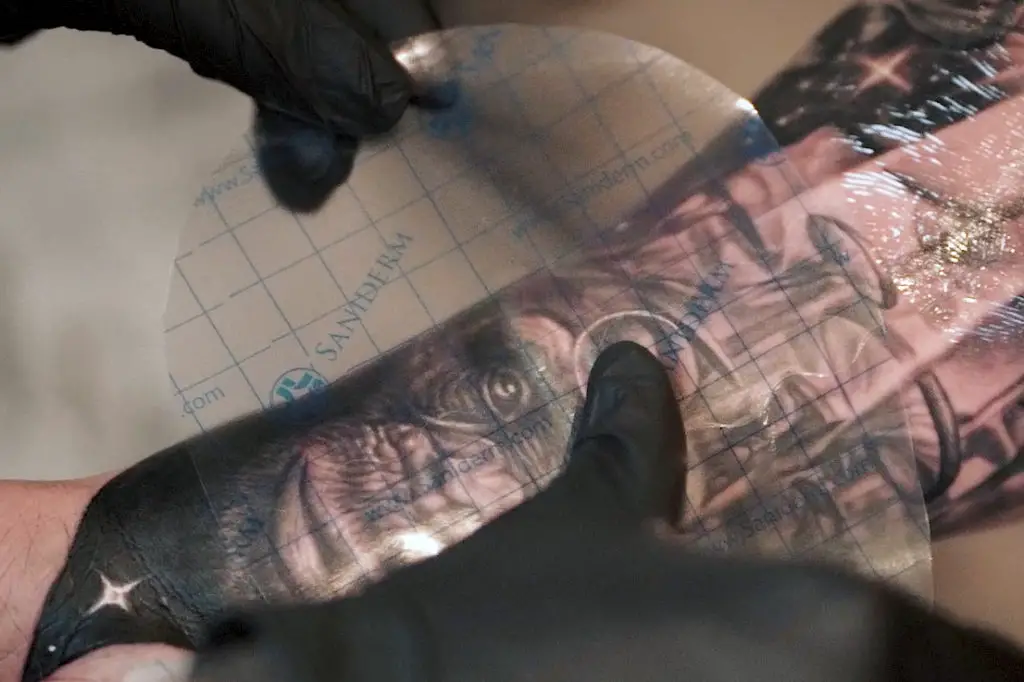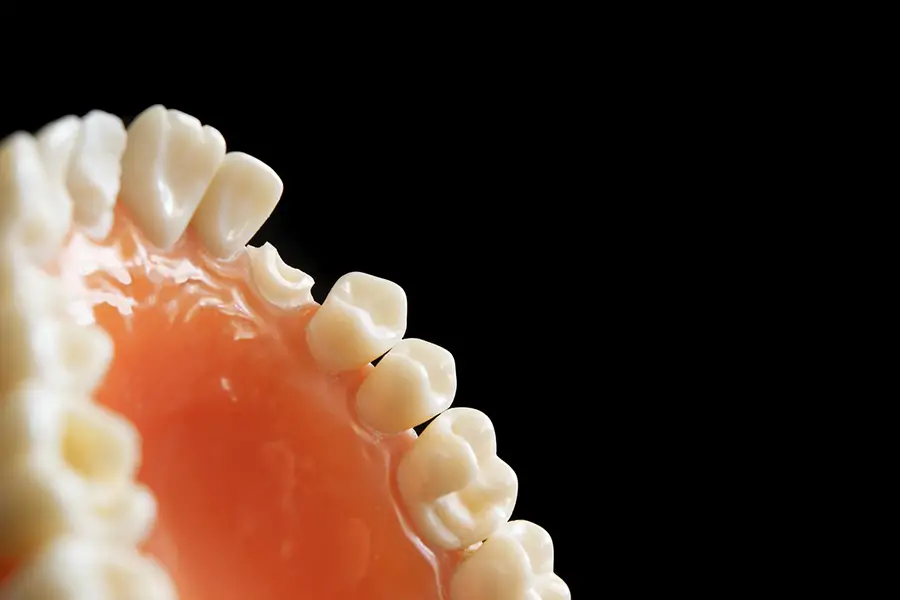Are you building your own first aid kit and trying to figure out what to put in it? Medical tape is one of the most crucial pieces of equipment to add to your kit. There are many types of medical tape and even more uses for it. When you are finished reading this, you will be ready to add the right medical tape to your first aid kit.
- What are medical tapes made of?
- What types of medical tapes are available?
- Special considerations with tape
- Best medical tape for sensitive skin
- Best medical tape for the elderly
- Best medical tape for adhesive allergies
- Strongest adhesive medical tape for your skin
- Best medical tape for athletes
- Best medical tape for babies
- Best medical tape for dogs
- Best way to remove tape residue from the skin
- Best overall medical tape for first aid
- Medical tape uses
- Final thoughts
What are medical tapes made of?
Medical tapes are made of two main parts, the backing, and the adhesive. The backing material can vary and generally is what’s used to give the tape its name, i.e., paper, cloth, etc.
The adhesive is what makes the tape stick to your body or dressings. There are two main kinds of adhesives.
Acrylate
Acrylate adhesives offer a lot of versatility when it comes to your medical tape. The manufacturer can design the tape to have high or low tack (the ability to form a bond to the skin rapidly) and high or low peel strength (the ability to take the tape off).
Synthetic
Synthetic adhesives are very strong but do not offer breathability. They will also leave a residue on the skin when peeled. Since the synthetic adhesive is so powerful, it is not recommended that you use it where there will be repeated dressing applications or if you need to leave the tape on for an extended period of time.
If you want to learn more about tape adhesives, click here.
What types of medical tapes are available?
The list of medical tapes is long. You can purchase paper, transpore, cloth, waterproof, sports, and kinesiology tape. All medical tapes have pros and cons, which we will cover now.
Paper and Surgical Tape
Paper and surgical tapes are relatively synonymous and share the same pros and cons. Paper tapes can attach bandages, gauze, and other similar types of dressings to the skin. The tape has a soft outer texture and a gentle adhesive making it easy to change bandages frequently without causing further damage around the injury site.
Pros
- Hypoallergenic and latex-free– We constantly encountered patients with adhesives or latex listed under their allergy list on the ambulance. I have used paper tape to secure dressings and IVs without causing unnecessary discomfort.
- Low cost– Paper tape is relatively inexpensive compared to some other tape options available.
- Breathable– The breathable material makes it easy to maintain skin integrity.
Cons
- Initial adhesion to damp skin– You can apply the tape to damp skin, but it needs to be applied to dry skin for the best results. You can find more information about adhesion performance by clicking here.
- Not waterproof– If you keep the dressing site dry, it will stay in place for several days without being changed; however, if you are in an environment where the dressing may get saturated with water, you should select a different tape.
Transpore Tape
Transpore tape was the tape we most commonly used on the ambulance. This tape provides the best adhesion to the skin, in my opinion. Transpore tape is transparent and has pores to increase breathability, hence the name transpore tape. It has the same uses as paper tape; however, if you need to change dressings frequently, I would stick with paper tape because of how strong the transpore adhesive is.
Pros
- Hypoallergenic– Just like paper tape, transpore tape is designed to be hypoallergenic and latex-free; however, the adhesive does seem to be slightly stronger.
- Breathable- Transpore tape gets its name from being transparent and porous. The pours allow for the skin to breathe underneath the application site.
- Easy to tear- This tape is designed with bi-directional tearing in mind, which allows you to tailor the tape to fit your application needs.
- Easy adherence- I have applied this tape to a tremendous number of patients during my years riding on the ambulance. Aside from soaking wet patients, this tape has never failed to secure what I need it to.
Cons
- Hard to remove- This tape does a remarkable job of sticking to anything you apply it to, but that can also be a bad thing. When I have to take this tape off, it often will rip out my hair, which can be painful. If you stick the tape to a surface that isn’t skin, it is also hard to remove, and it leaves a residue behind that is hard to clean.
- Hard to find the end- Since the tape is transparent, it can be challenging to find the end when you need to rip off a piece. Once you find the end, it is especially hard when wearing gloves, so make sure you fold the end of your tape on itself for easy deployment.
Cloth Tape
Cloth tape is another excellent option to have in your first aid kit. Cloth tape has a woven backing that is breathable and easy to tear. You can use this tape to secure dressings like the previously listed tapes, but I primarily used it to secure splints on the ambulance because it seems to stick better to other objects than it does to skin.
Pros
- Support- This tape doesn’t stretch, which makes it ideal for securing SAM splints and other similar types of devices.
- Easy adherence- The tape is designed to adhere quickly to dry skin, clothing, or splinting materials. After proper application, cloth tape will stay in place for a long time.
Cons
- Not hypoallergenic- If you or the person you are caring for has an allergy to adhesives, this is not the tape to use.
- No damp skin– This tape will not work well if you are not able to keep the application site dry.
Waterproof Tape
Nexcare waterproof tape utilizes a strong adhesive along with cushioned foam to create comfortable protection for your application site. Band-aid waterproof tape can be used to secure dressings, but it won’t fall off easily when exposed to water since it is waterproof, making it a great option if you need to shower or frequently bathe without changing your dressings.
Pros
- Waterproof- This is an obvious pro since waterproof is in the name, but if you are in a wet environment, you will want this tape in your first aid kit. It is important to note that the tape does require the initial application site to be dry to provide the best results.
- Thick Cushion- The Nexcare’s thick and comfortable foam backing makes this tape ideal for tending to blisters or chaffing, which is why I always make sure I have some on my hiking and camping trips.
- Flexibility- This tape is designed to conform comfortably to almost anywhere on your body, including your fingers, wrists, and elbows.
- Hypoallergenic- If you or someone you are caring for has allergies to adhesives or latex, you can still use this tape.
Cons
- Takes up space- While the thickness of the tape can improve comfort for the wearer, this tape will take up more space in your first aid kit compared to the others.
- Hard to tear– This tape does not have the same bi-directional tape as the transpore tape, so it can be harder to tear. This is easily mitigated if you carry some scissors or trauma sheers in your kit.
Nexcare cushioned waterproof tape
Band-Aid waterproof tape
Athletic (Zinc Oxide) Tape
Have you seen professional athletes with their ankles or wrists taped? The tape you are most likely seeing is athletic tape. Athletic tape helps prevent injuries and adds support to sprains but has no cushion. It will be supportive long enough for you to get an actual brace or cast. Because it adheres well, it’s also good to cover hot spots where blisters are beginning to form.
There is also an athletic bandage or “Coban” available; however, Coban doesn’t have the same level of adherence and won’t last as long as athletic tape (it often sticks best to itself). It’s really more of a wrap. Coban also has a lot of stretch, so it won’t offer the same level of support. It’s thicker and meant for supporting joints, but still allows movement.
Pros
- Stiff yet flexible- This tape is rigid enough to support your joints, such as the wrists or ankles, yet it still adheres to the skin well, so you don’t have to stop and reapply the tape constantly because it keeps falling off.
- Easy to tear- Athletic tape is easy to tear, making it easy to fit your needs.
- Multiple Colors- Zinc oxide tape comes in a wide assortment of colors, ensuring your tape can fit your style.
Cons
- Short-term use only- If you leave the athletic tape on for too long, it may damage the skin when you take it off. You should change this tape out routinely to prevent injuries to the application site.
- Movement restrictive- While the stiffness of the tape provides excellent support, if you apply too much tape, it can become too restrictive.
Zinc Oxide Tape
Coban wrap
Kinesiology Tape
This isn’t a tape I would recommend to secure dressings or bandages; however, you can use it to treat muscle soreness and support joints. This tape is designed to increase blood flow to a specific area which, in theory, will speed up the healing process. It usually comes in precut sizes, but you can trim them to fit your needs.
Pros
- Can be worn for several days- Kinesiology tape was designed to lift the superficial layer of the skin, promoting increased blood flow. The unique adhesive material won’t irritate the skin and will stay on for several days without issue.
- Waterproof- Since you will wear the tape for several days, it only makes sense that it would be waterproof so you can shower with it without having to reapply the tape.
- Flexibility- This tape does not restrict your movement when applied and can be used almost anywhere on the body to promote healing.
Cons
- Flexibility- This is a pro but can also be a con. Kinesiology tape is not the tape to use if you need to support a sprained joint.
- Does it work? Some people I have talked to swear by this tape, stating that it made recovery much faster; however, there is still research that needs to be done to determine if there is a scientific reason as to why people feel better or if it’s all in their heads.
Special considerations with tape
As you can see, there are many tape options available to choose from. When selecting the best tape for carrying in your first aid kit, you should ask yourself what situations you might need to use tape in.
Best medical tape for sensitive skin
If you or someone you could be treating have sensitive skin, you may need to carry tape specifically with that in mind. Most of the tapes we talked about above will be acceptable for patients with sensitive skin; however, you may need to change the tape more frequently to lessen the skin irritation from the adhesive.
Best medical tape for the elderly
It’s no secret that as we get older, we become more frail. One area that becomes especially frail is the skin. The elderly population has thinner skin compared to their younger counterparts. Delicate skin leaves the elderly susceptible to skin tears from falling, but also from taking off the medical tape. That is why I recommend using paper tape when caring for the elderly.
Paper tape adheres to the skin well, but it isn’t so strong that it will cause damage to your patient when removed. It is easy to apply and remove, making it easy to change dressings routinely without causing further injury.
Best medical tape for adhesive allergies
As I already told you, adhesive allergies are relatively common. Most medical tapes are made to be hypoallergenic; however, before you purchase your medical tape, ensure that it has the word hypoallergenic in the description. A number of the tapes we already covered have hypoallergenic in the pros section. It’s also worth reading product reviews as some people will still have negative reactions even if the tape calls itself hypoallergenic.
Strongest adhesive medical tape for your skin
The strongest short-term adhesive medical tape for your skin is transpore tape. That is why transpore tape is widely used by ambulance providers and hospitals to secure dressings and IV sites.
Best medical tape for athletes
The best medical tape for athletes is obviously athletic tape. This tape supports the joints necessary to prevent injury while playing their specific sport. Kinesiology tape is a close second because it promotes increased blood flow and decreases inflammation if you believe what the companies claim. Since the tape is waterproof, it can be used in almost any sport, from soccer to swimming.
Best medical tape for babies
The top two medical tapes for babies are transpore and paper.
When my daughter was in the hospital with pneumonia as a baby, the staff had to give her IV antibiotics. They secured her IV site using transpore tape, and the tape lasted for several days without having to be changed; however, when the staff removed the tape, there was a lot of skin irritation and redness.
Paper tape doesn’t last as long but is helpful in securing dressings or IVs on babies because their skin is so sensitive.
Best medical tape for dogs
If you are treating your furry friend’s injury, there are a couple of different options to choose from. The best option is vet wrap which is essentially Coban. Either option will provide support, but the vet wrap will be better in keeping a dressing secure.
If you want to know more about how to be prepared to take care of your dog, see our article on dog first aid kits here.
Best way to remove tape residue from the skin
Even though most medical tapes are easy to take off and don’t leave much residue behind, it still happens. When you have medical tape residue left on your skin, soap and warm water are the best way to get it off. You could use some rubbing alcohol, but doing so will dry out your skin quickly.
Best overall medical tape for first aid
I have spent over 8-years in the medical field, and I can honestly say the best medical tape on the market is transpore tape. It adheres to the skin remarkably well, it’s hypoallergenic, and I have used it in almost any scenario you could think of.
Medical tape uses
There are many uses for medical tape that make it well worth it to carry in your first aid kit.
Securing dressings
Medical tape is the ideal way to secure medical dressings. You can place a medical dressing on everything that a bandaid wouldn’t cover. Simply place a 4×4 or larger-sized gauze over the injury site and secure it on all four sides with your medical tape. I especially like using transpore tape for this purpose.
Splinting
Whether you carry a commercial device like a SAM splint or you want to make your own splint in the field, using medical tape will help you secure the splint properly. Cloth tape and Kerlix with a SAM splint is my favorite way of creating comfortable stabilization until I get the patient to the hospital.
Keeping a Band-Aid in place
If you are placing an adhesive bandage near a joint or somewhere that experiences a lot of movement, you might consider using medical tape to help keep it in place. It can also use tape for an added layer of protection against dirt or water.
Treating a sucking chest wound
If you come across someone who has a hole in their thoracic cavity, front or back, and they are still breathing, they will likely have a sucking chest wound. Any penetrating trauma to the thoracic cavity needs to be covered with an occlusive dressing. You can make your own by taping three sides of a plastic bag and placing it over the wound, creating a seal.
Final thoughts
If I could choose just one tape, it would be transpore tape; however, it doesn’t hurt to carry multiple kinds of medical tape, as long as you have the space for it. No matter what you choose to carry, the most vital thing is to be prepared, which is why you need medical tape in your first aid kit.













Ben, you wrote a fantastic post! Surgical tape, often known as medical tape, is a pressure-sensitive adhesive tape used to hold a gauze or other dressing to a lesion in healthcare and first aid. There are several types of medical tapes available, and the tape should be used based on the user’s age, skin type, and adhesive allergies. Paper tape, for example, is ideal for babies and the elderly, but athletes should use zinc oxide tape, which is robust, flexible, and long-lasting.